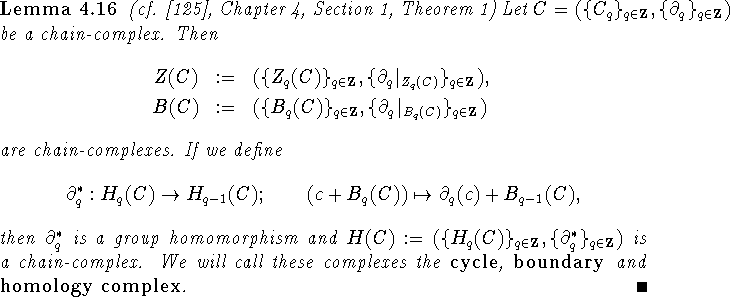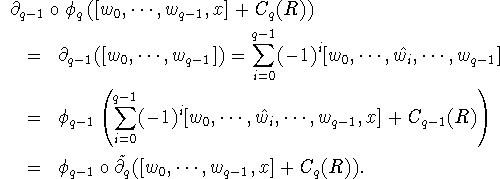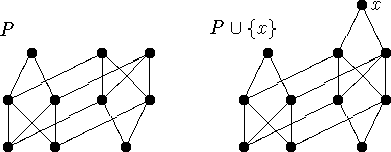
Here (specifically in Lemma 4.18) is ``where the miracle of algebraic topology occurs". Through Lemma 4.18 many Lefschetz numbers become computable and thus a host of combinatorially surprising fixed point theorems (many of which still have no combinatorial proof) enters the theory.



Proof:
First note that ![]() and
and
![]() , since for
, since for
![]() we have
we have
![]()
while for ![]() there is an
there is an ![]() with
with
![]() and thus
and thus
![]()
Now since ![]() and
and
![]() (with
(with ![]() being the
isomorphism) we have
being the
isomorphism) we have

Adding the two equations, multiplying with
![]() and summing over q gives the
equality of the Lefschetz numbers and the equality
of the Euler characteristics follows from
and summing over q gives the
equality of the Lefschetz numbers and the equality
of the Euler characteristics follows from
![]() . \
. \
Proof:
The generators for ![]() are the differences
v-w, where v,w are vertices of K with
are the differences
v-w, where v,w are vertices of K with ![]() .
Thus if u,z are vertices in the same component of K, then
.
Thus if u,z are vertices in the same component of K, then
![]() .
On the other hand if
.
On the other hand if ![]() , then u-z must the the sum
of finitely many generators of
, then u-z must the the sum
of finitely many generators of ![]() and thus u and
z must be in
the same component of K.
and thus u and
z must be in
the same component of K.
Since ![]() , the vertex set of K, this implies
that any two vertices x,y in the same component of K
satisfy
, the vertex set of K, this implies
that any two vertices x,y in the same component of K
satisfy ![]() , while if
x' and y' are not in the same component of
K we have
, while if
x' and y' are not in the same component of
K we have ![]() .
Hence
.
Hence ![]() has exactly k generators with no further
conditions to be satisfied, i.e., it is isomorphic to
has exactly k generators with no further
conditions to be satisfied, i.e., it is isomorphic to
![]() . \
. \
In particular this means that if K is connected, then
![]() is isomorphic to
is isomorphic to ![]() .
If this is the only interesting homology group of K, we
will say that K is acyclic.
.
If this is the only interesting homology group of K, we
will say that K is acyclic.

Clearly a simplicial complex is the clique complex of a graph iff it satisfies the clique condition (cf. [46], Proposition 4.4, or originally [125], Gikas also investigates the Euler characteristic of the chain complex of an ordered set in [46], Chapter 4).
Proof:
First note that if ![]() is a simplex
of K that does not contain x, then
is a simplex
of K that does not contain x, then
![]() .
On the other hand no nonzero sum of orientations of
simplexes that all contain x can ever be in
.
On the other hand no nonzero sum of orientations of
simplexes that all contain x can ever be in ![]() .
Thus the cosets of the orientations of the simplexes that contain x
are a set of generators for
.
Thus the cosets of the orientations of the simplexes that contain x
are a set of generators for ![]() with
no equations beyond
with
no equations beyond ![]() for
for ![]() being an odd permutation
to be satisfied.
being an odd permutation
to be satisfied.
Let ![]() . If
. If
![]() is a simplex that contains
x, we can find a representative
is a simplex that contains
x, we can find a representative ![]() of
of
![]() such that
such that
![]() .
Since any two such representatives only differ by an even permutation
of the indices up to q-1
we have that
.
Since any two such representatives only differ by an even permutation
of the indices up to q-1
we have that ![]() is a well-defined map
from the
set of orientations of simplexes that contain x to
is a well-defined map
from the
set of orientations of simplexes that contain x to ![]() .
Since the orientations of simplexes
that contain x are a system of representatives for
the generators of
.
Since the orientations of simplexes
that contain x are a system of representatives for
the generators of ![]() and their inverses and since
and their inverses and since

![]() extends in a natural fashion to a homomorphism
from
extends in a natural fashion to a homomorphism
from ![]() to
to ![]() , which we will
also call
, which we will
also call ![]() .
For q=1, we let
.
For q=1, we let ![]() ,
,
![]() and extend this in the natural fashion
to a homomorphism.
Surjectivity of
and extend this in the natural fashion
to a homomorphism.
Surjectivity of ![]() follows from the clique condition and
if
follows from the clique condition and
if

then  , which implies that
, which implies that
![]()
Thus ![]() is an isomorphism
(for q=1 this is trivial).
To see the equation
is an isomorphism
(for q=1 this is trivial).
To see the equation
![]() for
for ![]() consider:
consider:

For ![]() the statement for the homology groups is now trivial.
For q=0 note that
the statement for the homology groups is now trivial.
For q=0 note that ![]() is the whole
group
is the whole
group ![]() (which is generated by
(which is generated by
![]() ) in case there is a
) in case there is a ![]() such that
such that
![]() and that
and that ![]() if not.
For q=1
note that
the generators of
if not.
For q=1
note that
the generators of ![]() are the set
are the set
![]() while the generators of
while the generators of ![]() are the set
are the set
![]() Thus any difference
Thus any difference
![]() with a,c in the same component
of
with a,c in the same component
of ![]() is in
is in ![]() and no difference
and no difference
![]() with a,d in different components of
with a,d in different components of
![]() is in
is in ![]() .
If
.
If ![]() is connected, then
clearly
is connected, then
clearly ![]() and
and
![]() .
If
.
If ![]() is not connected,
let
is not connected,
let ![]() be the components of
be the components of ![]() and let
and let
![]() be a vertex of
be a vertex of ![]() .
Then the generators
.
Then the generators
![]() (
( ![]() )
are mutually
distinct and there are no equations between them to be
satisfied. Moreover all other elements of
)
are mutually
distinct and there are no equations between them to be
satisfied. Moreover all other elements of ![]() are
sums of these generators and their inverses.
This proves the claim.
\
are
sums of these generators and their inverses.
This proves the claim.
\
Theorem 4.25, which is an easy consequence of Lemmas 4.22 and 4.24, provides an algorithm to compute the homology of collapsible ordered sets. These are defined as follows.
Obviously (connected) collapsibility is a generalization of dismantlability. However while dismantlability of an ordered set can be determined in polynomial time, it is not clear if the same can be said for (connected) collapsibility (cf. open question 3). Connected collapsibility also gives some insight in the structure of the sets of fixed points of order-preserving maps (cf. Theorem 5.6). The definition of connectedly collapsible graphs is analogous and we can record:
Proof:
Let G=(V,E) be a connectedly collapsible
graph.
We prove the statement by induction on n=|V|.
For n=1 there is nothing to prove.
Now suppose ![]() and the result holds for all
graphs with
and the result holds for all
graphs with ![]() .
Let G=(V,E) be a graph with |V|=n. Then
by the definition of connected collapsibility
there is an
.
Let G=(V,E) be a graph with |V|=n. Then
by the definition of connected collapsibility
there is an ![]() such that
such that ![]() is a retract of
V,
is a retract of
V, ![]() is connectedly collapsible and
is connectedly collapsible and
![]() is connectedly collapsible.
Then
is connectedly collapsible.
Then ![]() is not an empty graph (since the empty graph is not
connectedly collapsible). Thus
since both
is not an empty graph (since the empty graph is not
connectedly collapsible). Thus
since both ![]() and
and ![]() have
at most n-1 vertices both are acyclic.
Thus by Theorem 4.25 G is acyclic.
\
have
at most n-1 vertices both are acyclic.
Thus by Theorem 4.25 G is acyclic.
\
Proof: Dismantlability implies connected collapsibility. \
Proof:
``2 ![]() 3" follows from
Theorem 4.27.
``3
3" follows from
Theorem 4.27.
``3 ![]() 1"
follows from Lemma 4.21.
Finally for ``1
1"
follows from Lemma 4.21.
Finally for ``1 ![]() 2"
suppose P is collapsible and not connectedly collapsible.
We will prove by induction on n:=|P|
that P does not have the fixed point property.
For n=1 there is nothing to prove.
Suppose now n>1 and the result holds for all ordered sets
Q with
|Q|<n. Then there is a retractable point
2"
suppose P is collapsible and not connectedly collapsible.
We will prove by induction on n:=|P|
that P does not have the fixed point property.
For n=1 there is nothing to prove.
Suppose now n>1 and the result holds for all ordered sets
Q with
|Q|<n. Then there is a retractable point ![]() such that
such that
![]() is collapsible and not connectedly collapsible
or
is collapsible and not connectedly collapsible
or
![]() is
collapsible and not
not connectedly collapsible. By induction hypothesis
this would mean that
is
collapsible and not
not connectedly collapsible. By induction hypothesis
this would mean that
![]() does not have the fixed point property
or
does not have the fixed point property
or
![]() does not have the fixed point property or it is empty
(in which case it also does not have the fixed point property).
This implies by Theorem 3.4 that P does not have the
fixed point property. \
does not have the fixed point property or it is empty
(in which case it also does not have the fixed point property).
This implies by Theorem 3.4 that P does not have the
fixed point property. \
Again clearly a similar result can be proved relating collapsibility of graphs to acyclicity and the fixed clique property.

Figure 3: Figures to illustrate example 4.30.
It is finally worth recording that (obviously) since the homology of an ordered set and the associated complexes are defined through the comparability graph they all are comparability invariants and thus only useful in the study of other comparability invariants.